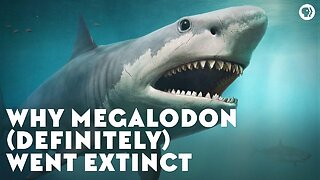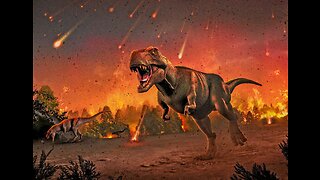Mastodon and its extinction
00:00 - Mastodon and its extinction
00:05 - 1 - What were they:
Mastodons are relatives of elephants belonging to the genus Mammut that inhabited North and Central America before they went extinct about 10,000 to 11,000 years ago. Typical adults stood between 8 and 10 feet (2.5-3 m) tall at the shoulder and weighed around 8,000 to 12,000 pounds (3,600-5,400 kg). The largest specimen found was 10.7 feet (3.3 m) tall and weighed 24,000 pounds (11,000 kg). They lived in herds, mainly feeding on leaves and branches, a lot like modern elephants.
Although some evidence suggests climate change may have contributed to their extinction, it is generally believed that human hunting by Paleo-Indians was the main factor in their disappearance.
Around 13,200 years ago, a roving male mastodon died in a bloody mating-season battle with a rival in what today is northeast Indiana, nearly 100 miles (160 km) from his home territory, according to the first study to document the annual migration of an individual animal from an extinct species.
The 8-ton (7,200 kg) adult, known as the Buesching mastodon, was killed when an opponent punctured the right side of his skull with a tusk tip, a mortal wound that was revealed to researchers when the animal’s remains were recovered from a peat farm near Fort Wayne in 1998.
01:35 - 2 - Evidence:
Northeast Indiana was likely a preferred summer mating ground for this solitary rambler, who made the trek annually during the last three years of his life, venturing north from his cold-season home, according to a paper published today (June 13, 2022) in Proceedings of the National Academy of Sciences.
The study also shows that the Buesching bull may have spent time exploring central and southern Michigan, which seems fitting for a creature whose full-size fiberglass-cast skeleton is on display at the University of Michigan Museum of Natural History in Ann Arbor.
02:10 - 3 - Your travels:
“The result that is unique to this study is that for the first time, we’ve been able to document the annual overland migration of an individual from an extinct species,” said University of Cincinnati paleoecologist Joshua Miller, the study’s first author.
“Using new modeling techniques and a powerful geochemical toolkit, we’ve been able to show that large male mastodons like Buesching migrated every year to the mating grounds.”
02:37 - 4 - The excavations
U-M paleontologist and study co-leader Daniel Fisher participated in the Buesching mastodon excavation 24 years ago. He later used a bandsaw to cut a thin, lengthwise slab from the center of the animal’s banana-shaped, 9.5-foot right tusk, which is longer and more completely preserved than the left.
That slab was used for the new isotopic and life-history analyses, which enabled scientists to reconstruct changing patterns of landscape use during two key periods: adolescence and the final years of adulthood. The Buesching mastodon died in a battle over access to mates at age 34, according to the researchers.
“You’ve got a whole life spread out before you in that tusk,” said Fisher, who has studied mastodons and mammoths for more than 40 years and helped excavate several dozen of the extinct elephant relatives.
“The growth and development of the animal, as well as its history of changing land use and changing behavior—all of that history is captured and recorded in the structure and composition of the tusk,” said Fisher, a professor of earth and environmental sciences, a professor of ecology and evolutionary biology, and a curator at the U-M Museum of Paleontology.
03:51 - 5 - Areas covered:
The team’s analyses revealed that the Buesching mastodon’s original home range was likely in central Indiana. Like modern-day elephants, the young male stayed close to home until he separated from the female-led herd as an adolescent.
As a lone adult, Buesching traveled farther and more frequently, often covering nearly 20 miles per month, according to the researchers. Also, his landscape use varied with the seasons, including a dramatic northward expansion into a summer-only region that included parts of northeastern Indiana—the presumed mating grounds.
Under harsh Pleistocene climates, migration and other forms of seasonally patterned landscape use were likely critical for the reproductive success of mastodons and other large mammals. However, little is known about how their geographic ranges and mobility fluctuated seasonally or changed with sexual maturity, according to the new study.
But techniques to analyze the ratios of various forms, or isotopes, of the elements strontium and oxygen in ancient tusks are helping scientists unlock some of those secrets.
Research: Vitor hugo Lizardi Leonardi
About my channel of curiosities, this channel is to see and hear curiosities of our world in general, if possible leave your like and subscribe to have new notifications about new subjects, thank you very much
Come meet me, and give your opinion about the channel, for me it's very important!
—— ?? TALK TO ME.
Research: Vitor hugo Lizardi Leonardi
facebook: facebook.com/vitor.leonardi
instagran: instagram.com/vitorleonardi/
twitter: twitter.com/vitorleonardi
email: vitorleonardi99gmail.com
Music credits:
Evermore - Instrumental
Played: Shirless Violinist
Composed: Alan Menken
Produced: Shirless Violinist
Source: TSV Entertainment
Good reading ,The 7 Habits of Highly Effective People
https://www.amazon.com.br/Habits-Highly-Effective-People-Powerful/dp/1982137274/ref=asc_df_1982137274/?tag=googleshopp00-20&linkCode=df0&hvadid=379726347250&hvpos=&hvnetw=g&hvrand=6784634493429849819&hvpone=&hvptwo=&hvqmt=&hvdev=c&hvdvcmdl=&hvlocint=&hvlocphy=20104&hvtargid=pla-908915591470&psc=1
Hello friends, If you liked it, don't forget to LIKE and SUBSCRIBE to the channel, strengthen our work, it's very important, to expand the channel. I'll tell you, thank you
The channel was created to promote texts and sounds for us to think a little about life and how we can be very happy with the little we have, liked it, leave your LIKE, your comment as soon as possible, we will respond, thank you.
I'm a writer, I'm working on this project!
contact we will respond within 48 hours email: vitorleonardi99@gmail.com
#mastodons,#elephants,#genus mammut,#dwelled,#extinct,#specimen,#lived,#leaves and twigs,#modern elephants,#evidence,#climate change,#paleoindians,#disappearance,#contributed,#herds lived ,# vitorleonardi
-
 2:39
2:39
ComputerChick Productions
2 years agoMastodon State Park
80 -
 10:16
10:16
PeaceKeeper Reaction
4 months agoMASTODON - Colony Of Birchmen
3 -
 10:45
10:45
PBS_Eons
5 years agoWhy Megalodon (Definitely) Went Extinct
18 -
 5:35
5:35
LendianTV
4 months agoMegalodon - the Shark that Ruled the Oceans
16 -
 10:45
10:45
PBS_Eons
5 years agoWhy Megalodon (Definitely) Went Extinct
51 -
 1:43:31
1:43:31
Purple Soul
1 year agoThe Great Extinction
63 -
 1:48:59
1:48:59
GlobalStrangeness
9 months agoMegalodon and other Aquatic Cryptids 2
14 -
 59:40
59:40
Comicfreak
10 months ago $0.07 earnedThe Extinction of The Dinosaurs and After
242 -
 1:37
1:37
Creator awal
2 years agoMegalodon shark in the open ocean which is becoming extinct
1156 -
 3:44
3:44
JETHOMASCUOUS
1 year agoMASTODON AT FIRST GLANCE
2